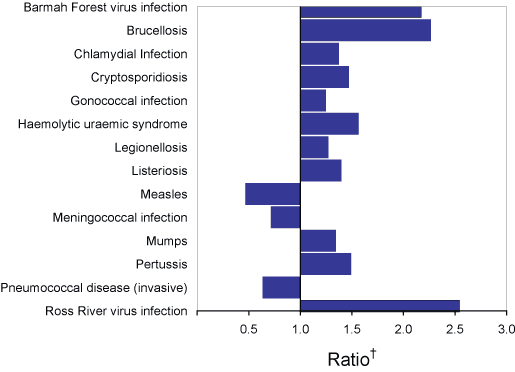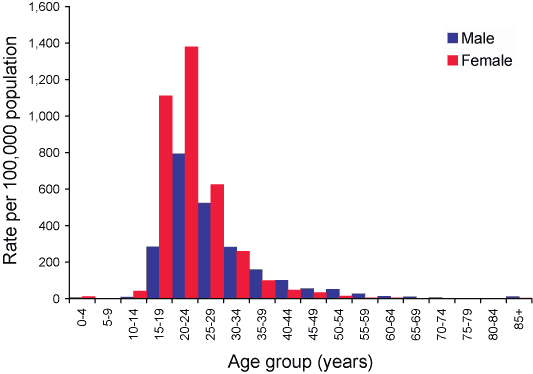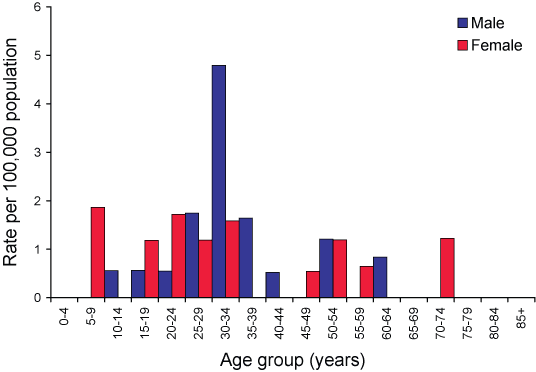Communicable Disease Surveillance Highlights report on data from various sources, including the National Notifiable Diseases Surveillance System (NNDSS) and several disease specific surveillance systems that provide regular reports to Communicable Diseases Intelligence. These national data collections are complemented by intelligence provided by State and Territory communicable disease epidemiologists and/or data managers. This additional information has enabled the reporting of more informative highlights each quarter.
The NNDSS is conducted under the auspices of the Communicable Diseases Network Australia. NNDSS collates data on notifiable communicable diseases from State or Territory health departments. The Virology and Serology Laboratory Reporting Scheme (LabVISE) is a sentinel surveillance scheme which collates information on laboratory diagnosis of communicable diseases. In this report, data from the NNDSS are referred to as ‘notifications’ or ‘cases’, and those from ASPREN are referred to as ‘consultations’ or ‘encounters’ while data from the LabVISE scheme are referred to as ‘laboratory reports’.
Figure 1 shows the changes in select disease notifications with an onset in the first quarter of 2006, compared with a five year mean for the same period. The following diseases were above the five year mean: cryptosporidiosis, haemolytic uraemic syndrome, listeriosis, chlamydial infection, gonococcal infection, mumps, pertussis, Barmah Forest virus infection, Ross River virus infection, brucellosis and legionellosis. Diseases for which the number of notifications was below the five year mean for the same period include hepatitis A, measles, pneumococcal disease and meningococcal infection.
Figure 1. Selected* diseases from the National Notifiable Diseases Surveillance System, comparison of provisional totals for the period 1 January to 31 March 2006 with historical data†

Top of page
Gastrointestinal illnesses
Cryptosporidiosis
There were 1,454 notifications of cryptosporidiosis during the quarter which was 1.5 times the five year mean for the same period. All jurisdictions reported cases but the majority were from New South Wales, Victoria and Queensland. This continued a trend reported in the last quarter. One thousand and twenty-two notifications (70%) had information on the infecting species and all were identified as Cryptosporidium parvum infection.
A report for the Communicable Diseases Network of Australia on the increases in cryptosporidiosis in this quarter concluded that seasonal increases in cryptosporidiosis had been higher and more prolonged in 2005 and 2006 compared to the previous four years. Cryptosporidiosis had increased in New South Wales and Victoria and declined in Queensland although this State continues to report a significant proportion of all cases. A relative increase was observed in the proportion of notifications in cases aged more than four years compared with those aged less than four years, particularly in Victoria (Rhonda Owen, personal communication).
Listeriosis
There were 24 cases of listeriosis reported to NNDSS in the first quarter which was 1.4 times the five year mean. Nine cases were from New South Wales and eight from Western Australia. The cases occurred in the elderly (19 of the 24 cases were aged 60 years or more) and in people with underlying medical conditions. OzFoodNet undertook investigations for a common food source (see OzFoodNet report).
Top of page
Sexually transmissible infections
Chlamydial infections
There were 10,492 notifications of chlamydial infection in the quarter which was 1.4 times the five year mean. The highest rates of notification continue to be among young women (1,378 cases per 100,000 population) and men (794 cases per 100,000 population).
Figure 2. Notification rates of chlamydial infections, Australia, 1 January to 31 March 2006, by age group and sex

Top of page
Vaccine preventable diseases
Measles
There were 11 cases of measles reported in the quarter. Cases were reported from New South Wales (5 cases), Victoria (4 cases) and one case each in South Australia and Western Australia. Of the 11 cases, seven were male and four female; three were aged less than five years and the remainder were aged between 20 and 30 years. All of the seven cases with vaccination status recorded were unvaccinated.
Mumps
There were 40 notifications of mumps in the quarter, which was 1.3 times the five year mean for the same period. There were 22 male and 18 female cases with an age range from 6 to 72 years (Figure 3).
Figure 3. Notification rates of mumps, Australia, 1 January to 31 March 2006, by age group and sex

The vaccination status data in the notifications showed that one case was partially vaccinated, 22 were not vaccinated while the vaccination status for the remaining 17 cases was unknown.
Pertussis
Two thousand two hundred and forty-eight pertussis notifications were received in the quarter which was 1.5 times the five year mean for the same period. Of the total number of notifications, 1,059 were reported by New South Wales and 467 were from Queensland. Of the 2,248 notifications 1.4 per cent (32 cases) were reported in infants aged less than one year. The highest rate of infection in females (100 cases per 100,000 population) occurred in the 50–54 year age group. The highest rate in males was 73 cases per 100,000 population in the 65–69 year age group.
Top of page
Vectorborne diseases
Barmah Forest virus infection
There were 703 cases of Barmah Forest virus (BFV) infection in the fourth quarter which was 2.2 times the five year mean for the same period. The majority of cases were from Queensland (265 cases) and New South Wales (265 cases). Nationally, the infection rate was 13.8 cases per 100,000 population, but it was higher in the Northern Territory at 96.7 cases per 100,000 population (49 cases) and Queensland with 26.7 cases per 100,000 population.
Ross River virus infection
This quarter, 3,228 notifications of Ross River virus infection were reported compared to 928 in the same period last year. The majority of cases were from Queensland (1,583) and New South Wales (680), while the notification rates were above the national rate in the Northern Territory, Queensland and Western Australia.
Top of page
Other bacterial infections
Legionellosis
There were 98 cases of legionellosis reported in the first quarter, which was 1.3 times the five year mean. Twenty-nine cases were reported in both New South Wales and Victoria, which included cases in outbreaks in metropolitan Sydney and Melbourne respectively.
Meningococcal infection
There were 74 notifications of meningococcal infection in the quarter which was 70 per cent of the five year mean. Of the 74 cases, 44 (59%) were serogroup B, 7 (9%) were serogroup C, 3 were serogroup W135, 1 was serogroup Y and the serogroups of the remaining 17 cases was unknown. There were two deaths reported in the quarter, both in patients with serogroup B disease.
Of the serotype C cases, two were eligible for vaccination – one of these was a fully vaccinated 15-year-old, and one was a 5-year-old who was not vaccinated. The remaining cases were aged 24 to 74 years. Serogroup C disease continues to decline in Australia as a result of the National Meningococcal C Vaccination Program which commenced in 2003 and completed vaccination of all under 19-year-olds by the end of 2004.
This report was published in Communicable Diseases Intelligence Vol 30 No 2, June 2006.
